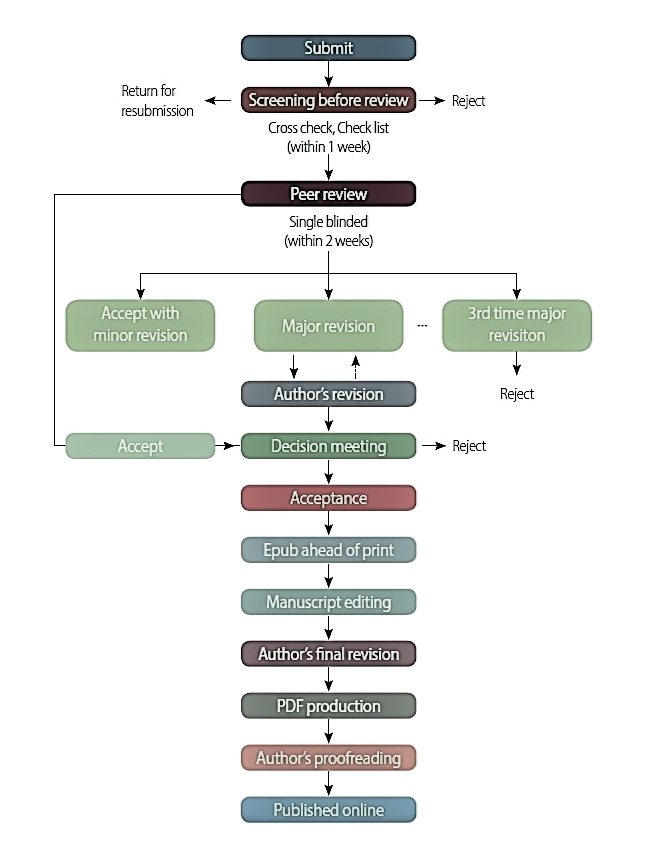Peer review process
Peer review exists to ensure that journals publish good science which is of benefit to entire scientific community
Peer review is the system used to assess the quality of a manuscript before it is published. Independent researchers in the relevant research area assess submitted manuscripts for originality, validity and significance to help editors determine whether a manuscript should be published in their journal.
Peer review is an integral part of scientific publishing that confirms the validity of the science reported. Peer reviewers are experts who volunteer their time to help improve the journal manuscripts they review-they offer authors free advice.
Of course, in addition to offering authors advice, another important purpose of peer review is to make sure that the manuscripts published in the journal are of the correct quality for the journal’s aims.
When a manuscript is submitted to a journal, it is assessed to see if it meets the criteria for submission. If it does, the editorial team will select potential peer reviewers within the field of research to peer-review the manuscript and make recommendations.
There are three main types of peer of peer review used:
Single-blind: the reviewers know the names of the authors, but the authors do not know who reviewed their manuscript unless the reviewer chooses to sign their report.
Double-blind: the reviewers do not know the names of the authors, and the authors do not know who reviewed their manuscript.
Open peer: authors know who the reviewers are, and the reviewers know who the authors are. If the manuscript is accepted, the named reviewer reports are published alongside the article.
GRF follows double blind peer review process- in this case neither authors nor reviewers know each other’s identities.
Importance
Peer review is an integral part of scientific publishing that confirms the validity of the manuscript. Peer reviewers are experts who volunteer their time to help improve the manuscripts they review. By undergoing peer review, manuscripts should become:
More robust : peer reviewers may point out gaps in a paper that require more explanation or additional experiments.
Easier to read : if parts of your paper are difficult to understand, reviewers can suggest changes.
More useful : peer reviewers also consider the importance of your paper to others in your field.
Publishers : Transparent business model, ultimate online article distribution, ultimate visibility for articles.
Editorial rejection
Your journal manuscript can be rejected if it:
- Lacks proper structure.
- Lacks the necessary detail for readers to fully understand the authors' analysis.
- Has no new science.
- Does not clearly explain which parts of the findings is new science, versus what was already known.
- Lacks up-to-date references.
- Contains theories, concepts, or conclusions that are not fully supported by its data, arguments, and information.
- Does not provide enough details about materials and methods to allow other scientists to repeat the experiment.
Lacks clear descriptions or explanations of:
- Hypotheses tested.
- The experimental design.
- Sample characteristics and descriptive statistics.
- Describes poor experimental design, or faulty or insufficient statistical analysis.
- Has poor language quality.
Publication is a difficult process, and you must be prepared to defend your submission against rejection from both editors and peer reviewers. However, do not be too persistent.
Revising
When revising your manuscript and responding to peer review comments:
- Address all points raised by the editor and reviewers.
- Describe the revisions to your manuscript in your response letter.
- Perform any additional experiments or analyses the reviewers recommend (unless you feel that they would not make your paper better; if this is the case, explain why in your response letter).
- Provide a polite and scientific rebuttal to any points or comments you disagree with.
- Differentiate between reviewer comments and your responses in your letter.
- Clearly show the major revisions in the text, either with a different colour text, by highlighting the changes, or with Microsoft Word's Track Changes feature.
- Return the revised manuscript and response letter within the time period the editorial assistant tells you.

